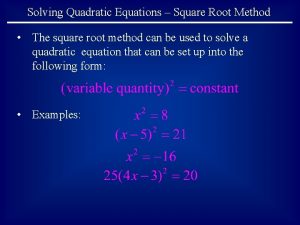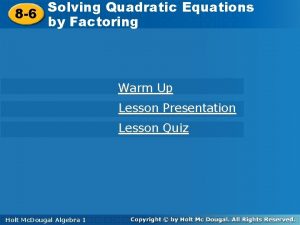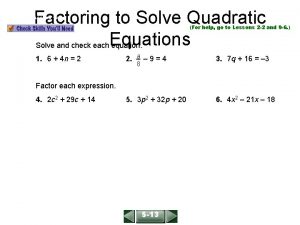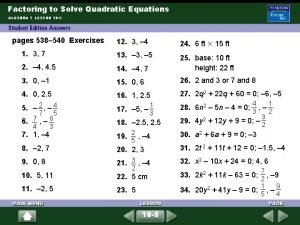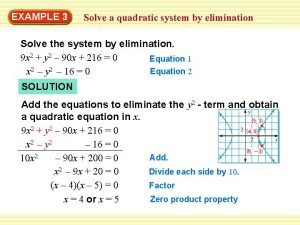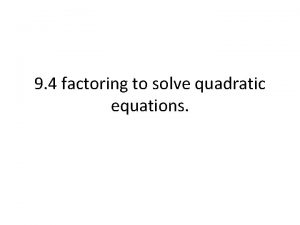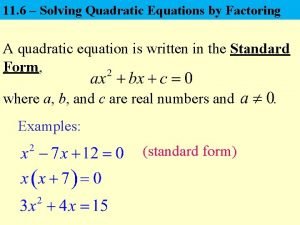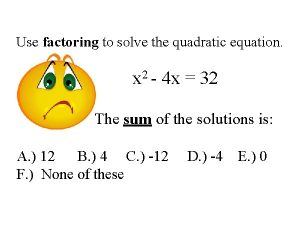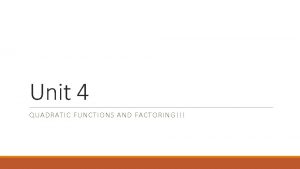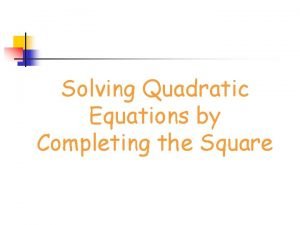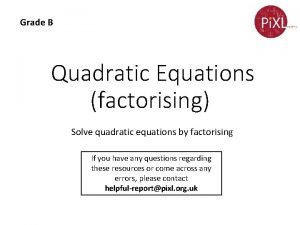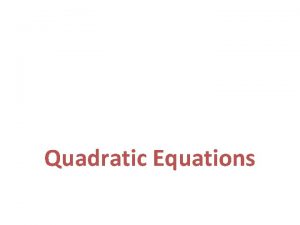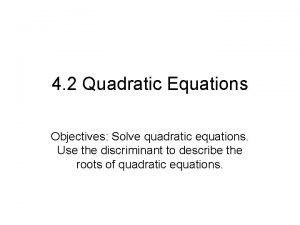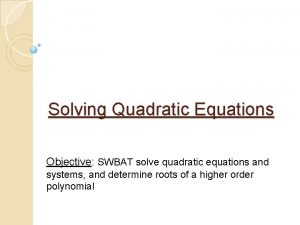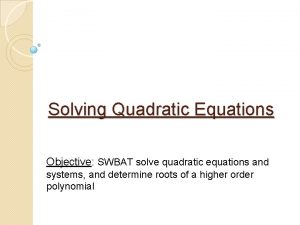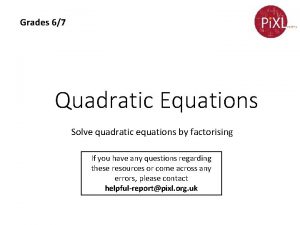Grade 6 Quadratic Equations factorising Solve quadratic equations











- Slides: 11

Grade 6 Quadratic Equations (factorising) Solve quadratic equations by factorising If you have any questions regarding these resources or come across any errors, please contact helpful-report@pixl. org. uk

Key Vocabulary Quadratic Factorise Factor Product Sum

How to solve by factorising To solve by factorising we need two brackets of the form: (x+. . )=0 When we multiply two numbers together and the product is zero, then one of the numbers must have been zero. For example x 2 - 8 x +7 can be factorised as follows: ( x-7) ( x -1)

How to solve by factorising So if x 2 - 8 x +7=0 then: ( x-7) ( x -1) =0 If the product of two numbers if zero then either (x-7)=0 or (x-1)=0 x-7=0 +7 +7 x=7 x-1=0 +1 +1 x=1 Therefore the solutions are x=7 and x=1

How to solve by factorising What happens if x 2 - 5 x = -6 REARRANGE to make equation equal to zero! x 2 - 5 x = -6 +6 +6 x 2 - 5 x +6 = 0 ( x-2)(x -3) =0 (x-2)=0 or (x-3)=0 x-2=0 +2 +2 x-3=0 +3 +3 x=2 x=3 Therefore the solutions are x=2 and x=3

Now you try Solve by factorising a)x(x+3)=0 b)x 2+ x -30 =0 c)x 2+ 18 x =-17 d) x 2 - 225 =0 e) 2 x(x-12) =0 f) 3 x 2+ 10 x +8 =0 g) 4 x 2 -24 x +27 =0 h) 16 x 2 -81 =0 i) 4 x 2 =6 x j) 3 x 2 -13 x =10

Now you try Solve by factorising a)x(x+3)=0 b)x 2+ x -30 =0 c)x 2+ 18 x =-17 d) x 2 - 225 =0 e) 2 x(x-12) =0 f) 3 x 2+ 10 x +8 =0 g) 4 x 2 -24 x +27 =0 h) 16 x 2 -81 =0 i) 4 x 2 =6 x j) 3 x 2 -13 x =10 x=0 or x=-3 x=-6 or x=5 x=-17 or x=-1 x=15 or x=-15 x=0 or x=12 x=-2 or x=-4/3 x=1. 5 or x=4. 5 x=2. 25 or x=-2. 25 x=0 or x=1. 5 x=-2/3 or x=5

Problem Solving A triangle has area 14 cm 2, by forming a quadratic equation find the value of x. Area of triangle: ½(base x perpendicular height) X-6 x-3 ½((x-6)(x-3))=14 X 2 (x-6)(x-3)=28 Need to make (x-6)(x-3) =x 2 -3 x -6 x +18 zero so have to expand brackets! 2 X -6 x - 3 x +18=28 Simplify 6 x and 3 x X 2 -9 x +18 =28

Problem Solving X 2 -9 x +18 =28 We need to make this equal to zero to be able to factorise! x 2 -9 x +18 =28 -28 x 2 -9 x -10 =0 X-6 (x-10)(x+1)=0 X-3 (x-10)=0 +10 x=10 (x+1)=0 -1 -1 x=-1 Solutions are x=10 or x=-1. However in context of question -1 would mean the triangle wouldn’t exist!

Reason and explain Spot the mistake: Solve x 2 -6 x -3 = 0 +3 +3 x 2 -6 x = 3 x(x-6) = 3 x =3 or x-6 = 3 +6 +6 x =3 or x= 9

Reason and explain Why do we make the equation equal to zero? Can we always factorise to find a solution? Give an example of when we cannot factorise?
 Discriminant formula
Discriminant formula Square root method examples
Square root method examples Solving quadratic equations
Solving quadratic equations Il factoring
Il factoring 9-4 factoring to solve quadratic equations
9-4 factoring to solve quadratic equations Solving linear-quadratic systems by elimination
Solving linear-quadratic systems by elimination 9-4 solving quadratic equations by factoring
9-4 solving quadratic equations by factoring Factored equation
Factored equation How to use factoring to solve quadratic equations
How to use factoring to solve quadratic equations Quadratic formula
Quadratic formula Complete quadratic
Complete quadratic Quadratic equation diamond method
Quadratic equation diamond method

